-
Posts
804 -
Joined
-
Last visited
Content Type
Profiles
Forums
Gallery
Events
Posts posted by robdurant
-
-
Stunning work. What a handsome ship!
-
Hi Tim,
Hope you don't mind me following along
Fly really is a handsome ship, and I'm sure you'll do a great job. It doesn't feel like two minutes since I built my first wooden model ship, and yet somehow six years and four models have come and gone! I couldn't have done it without the support and encouragement of the guys on this forum, so if I can pay it back at all and help you out in any way, let me know!
Rob
- chris watton and TimC
-
 2
2
-
That's looking really great Peter. The square section of the mast looks very crisp.
-
2 hours ago, George-JK said:
Hi,
thank you for the suggestion!
Can you send me, post here a detail of the stanchion? Also how tall are they, the ones I used are 14mm 3hole ones, if these are similar in size, that would be perfect.
Thanks!
Cheers,
George
Hi George.
I've only used the 1:48 stanchions but I would imagine they scale... so the 1:48 ones have 22mm showing above the deck, so that would make the 1:72 ones 14.6mm?
Do check they are even spacing... perhaps this link might be better
Rob
-
Hi.
I've really enjoyed reading through your log - Your model is coming together brilliantly. Your mention of the lack of stanchions made me wonder whether the following might suit (1:72 rather than 1:75, but perhaps close enough?):
(I have no connection with this company - I've just used them for fittings on models I've built in the past)
-
Thanks Jason, and to everyone who's spurred this project on with likes and encouragement!
The boats have taken a bit of a pause, but I do have a little progress to report.
-
The mainmast ratlines are complete *he pauses to celebrate!* - given how much my arms were aching, I may need to move the model down a little (or get a taller chair!) before I get too much stuck into the topmast ratlines!
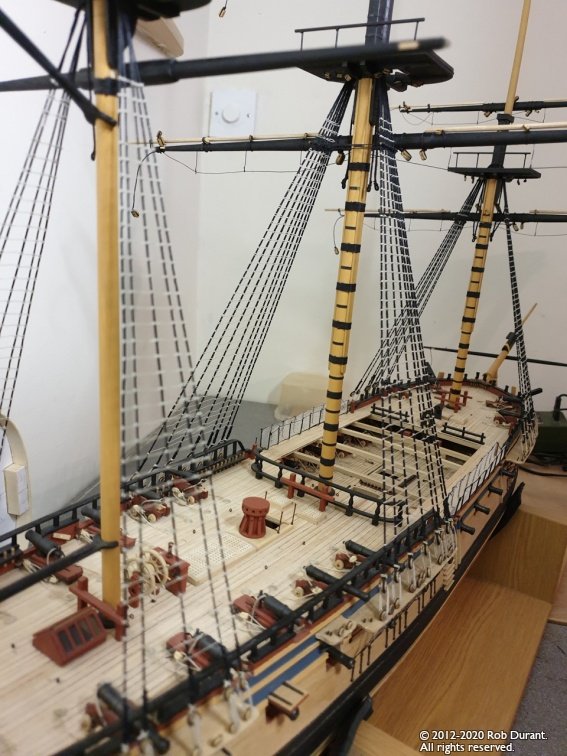
- I've also spent a fair bit of time putting all the fittings and detail onto the the yards, along with the rigging blocks. I'm about half way through, but the most detailed yards - the main and fore mainyards are complete. I used black card on the studding sail booms, as this seemed more to scale than the chunky white metal rings. They were fiddly little blighters to get fixed in place, but I'm pleased with the end result.
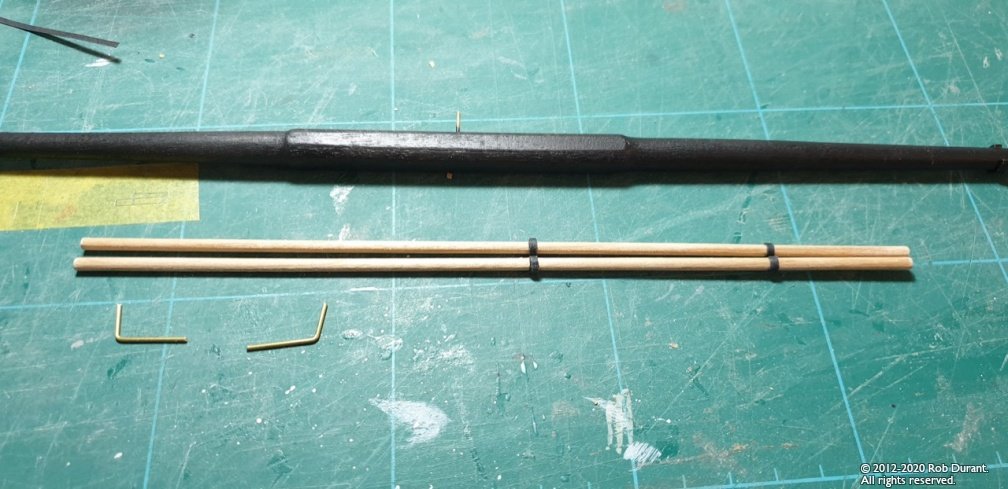
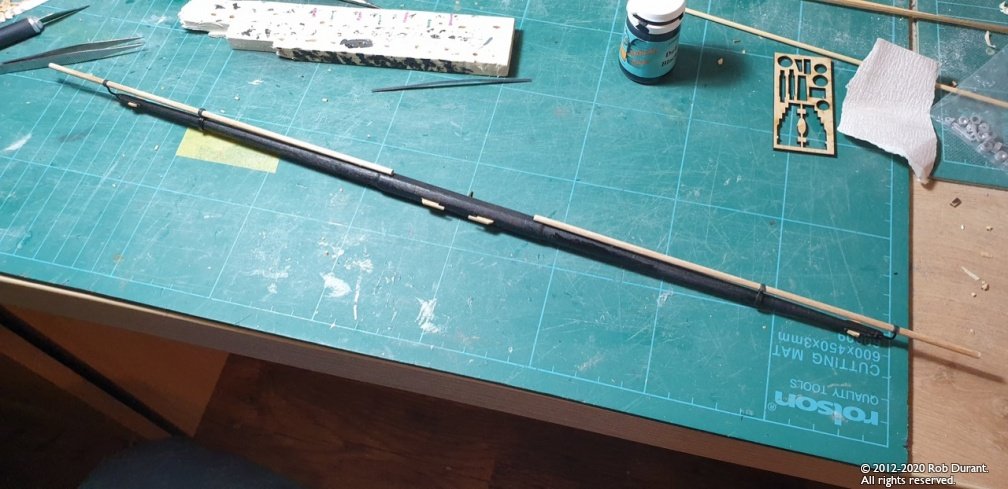
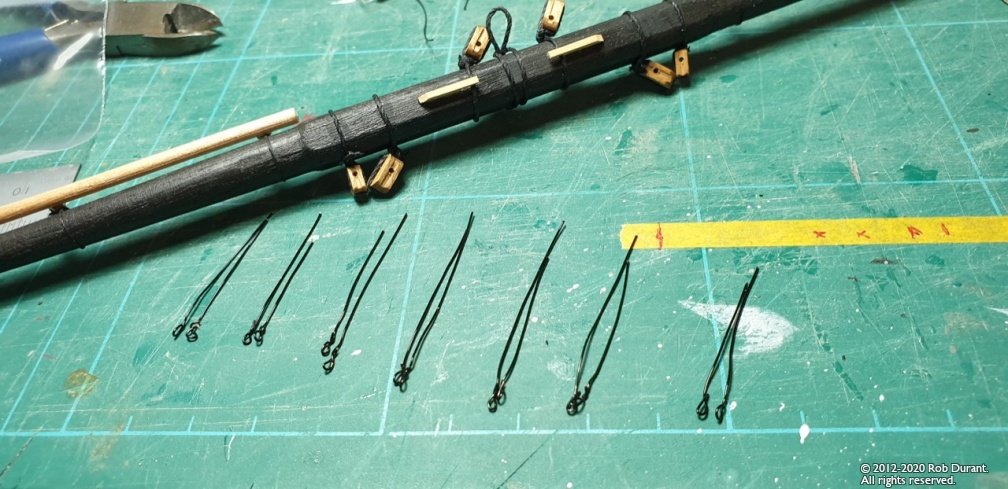
The stirrups are made out of jewellery wire. I've used it before, and it seems to do a nice job, and needs no painting afterwards, which prevents me making a goof-up.
Here's a final shot of how she stands as of yesterday evening... the captain wouldn't be pleased - the yards are just pinned, and are all ahoo (made worse with the wide angle) - but once the lifts get added, that'll improve a lot, I'm sure :)
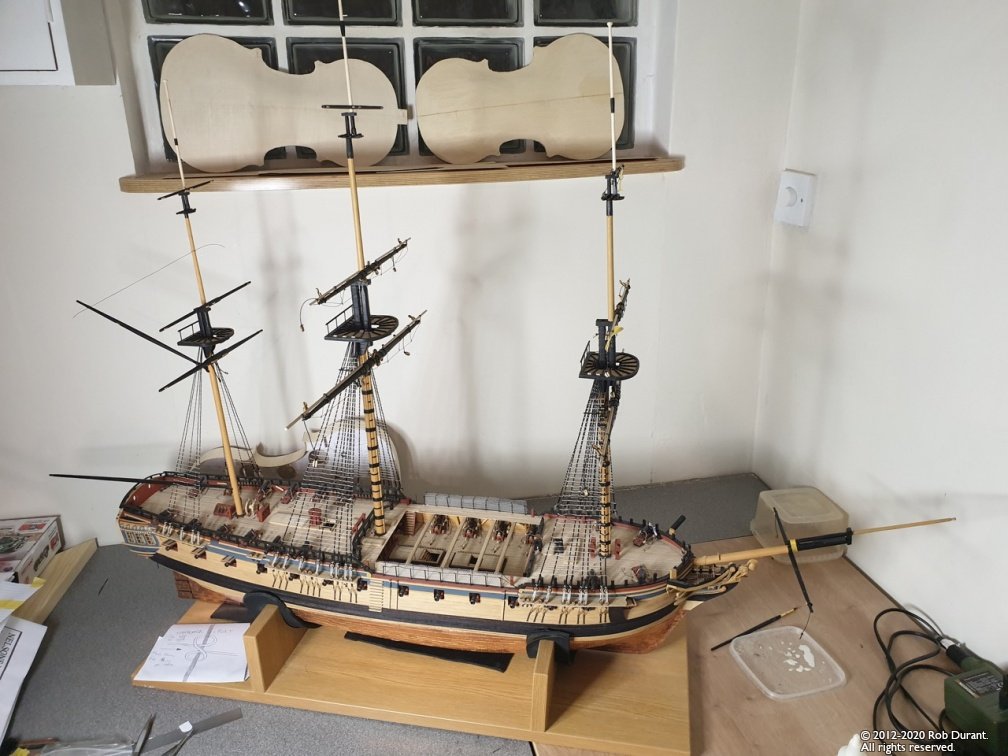
Happy building, all!
Rob
-
The mainmast ratlines are complete *he pauses to celebrate!* - given how much my arms were aching, I may need to move the model down a little (or get a taller chair!) before I get too much stuck into the topmast ratlines!
-
23 hours ago, Vane said:
Actually i have ordered new diamond files that are arriving tomorrow. Perhaps they will be up for the task. Otherwise i think there will be a combination of tools from various knifes, small razorsaws to files.
Through trial and error, I found that a brand new x-acto blade to gently carve away the excess was the best tool for me (taking off little by little) - sanding just caused tear out on one side or the other... But I didn't have nice new diamond files, so you may have a better experience.
Something to watch out for... I think there were a few places that the gunports meant there was no support for the internal (and external?) planks in between the ports (they did not land on any of the frames) - you may want to check and support those places before you drill them out. I simply packed some strip in to provide support to the planks above and below. -
Okay - I had the opportunity to make some real progress yesterday, so by midnight the yards were turned, and I'm beginning to pin them into position. I really love this part as the ship really begins to take her final form... The yards are just pinned in place, so are removable. I'll try and put as much of the rigging on before I fix them finally in place.
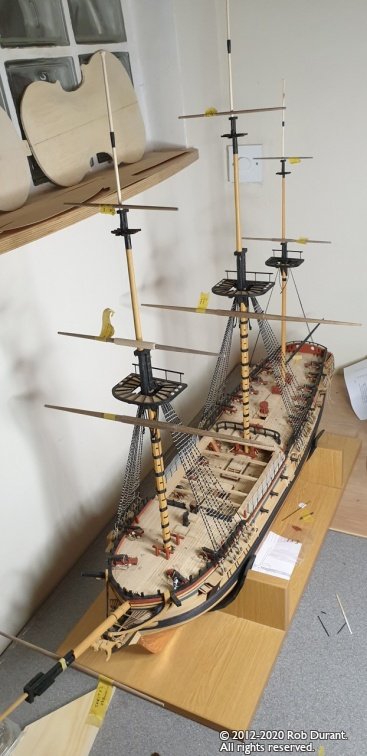
I'm toying with the idea of putting on royals as well - they turn up in the AOTS book, and I have the longer topgallant masts up, so I might just take the plunge. Could be fun!
I've also been messing about with the boats. I had another crack at the pinnace that comes in the kit. It's by no means finished, but it's on the way. The following picture shows the pinnace with a just started vanguard kit of the 18ft cutter beside it.
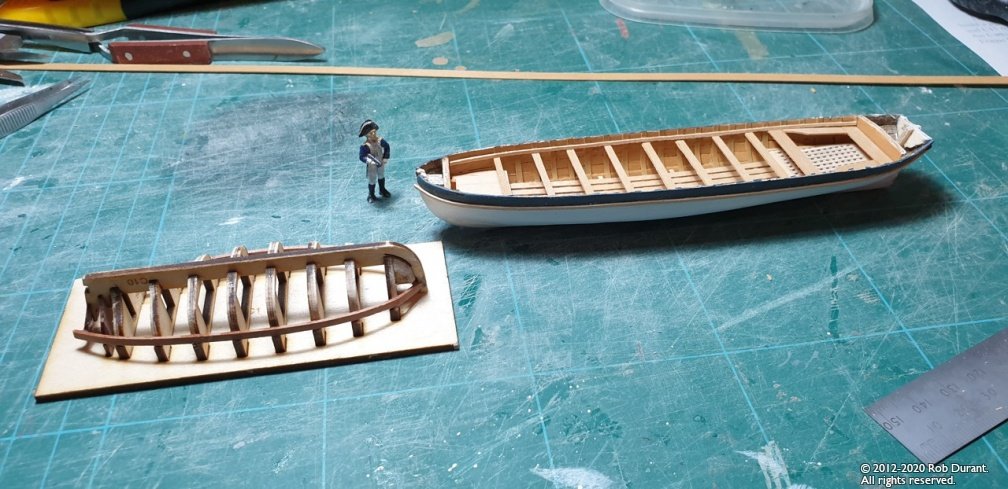
As a bit of fun, I bought a 1:64 model of a mini cooper (the Italian job model) and put it on the foredeck as a comparison... Not quite historical, but it gives you some idea of just how big these ships were.
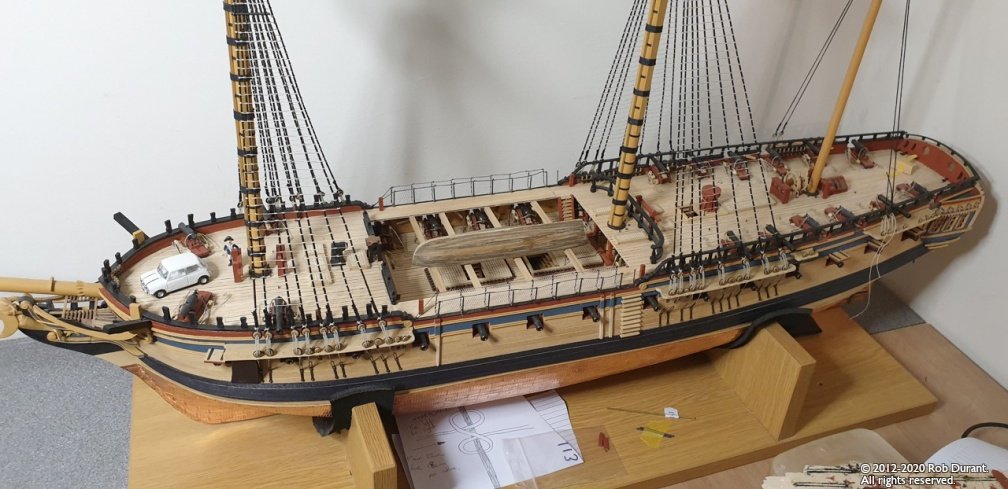
Happy building!
Rob
- CiscoH, mort stoll, Beef Wellington and 6 others
-
 9
9
-
32 minutes ago, chris watton said:
There are instructions for the binnacle, there is a PDF file on the binnacle product page. I think!
Aah - now I looked more closely for them I found them right where you left them on the website. I'll revise my post above to note this.
It's testament to your superb (and logical) design and laser-cutting that the construction was evident enough without the instructions, but yes, the instructions describe precisely the process I stumbled upon. I shall know to check the image icons more carefully next time
Perhaps a specific link labelled instructions which opened that image would be helpful on the page?
I'm so pleased with how the binnacle looks on the quarterdeck, and I notice you now provide the chimney as well - I would certainly have included that in the order, had it been an option then. As it was, I was simply challenged to think for myself, and that's no bad thing once in a while.Thanks Chris.
Rob
-
Not much to show, but I am still here. Thanks to everyone for the likes. As always, an encouragement - especially when tying knots one after the other.
Mainmast ratlines are complete.
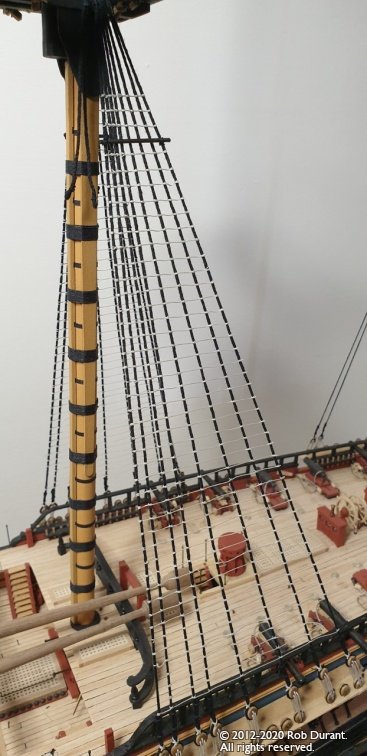
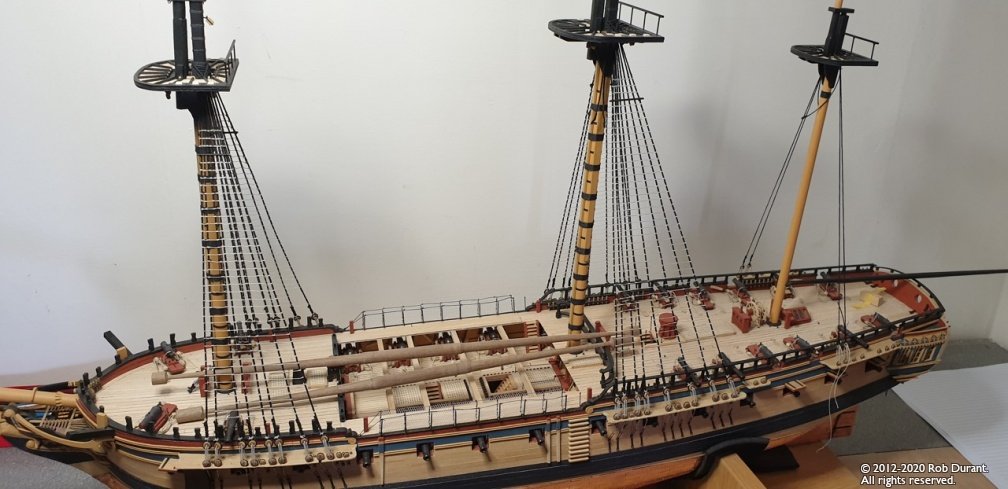
I plan to get some more yards done on the lathe now as a break from tying clove hitches!
Happy building
Rob
- JpR62, egkb, Beef Wellington and 3 others
-
 6
6
-
It's definitely a stage worth taking your time over. It will save a whole heap of woe later if you get a smooth run for the planks to the bow.
-
Well, the ratline tying continue apace, Foremast ratlines done, and the shrouds in place on the mainmast ready to rattle down... Nothing very exciting in terms of pictures... But I also had a nice parcel from Cornwall Model Boats containing the dowels I needed to get the yards done. So... Main yard and Fore main yard are begun. Here's my progress so far after an enjoyable hour with the lathe (just sat on top of the tops to get an idea of what they might look like). It's broken up the ratlines nicely
 Ready for the main mast now.
Ready for the main mast now.
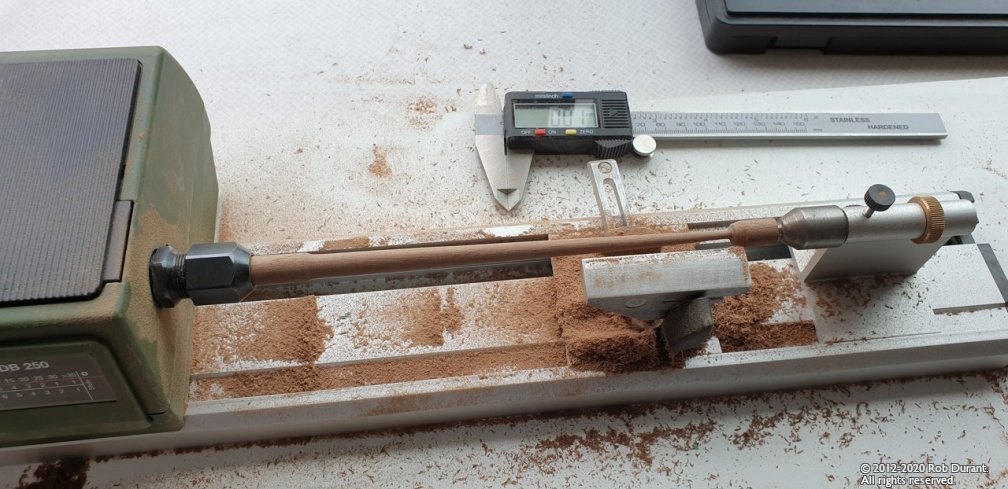
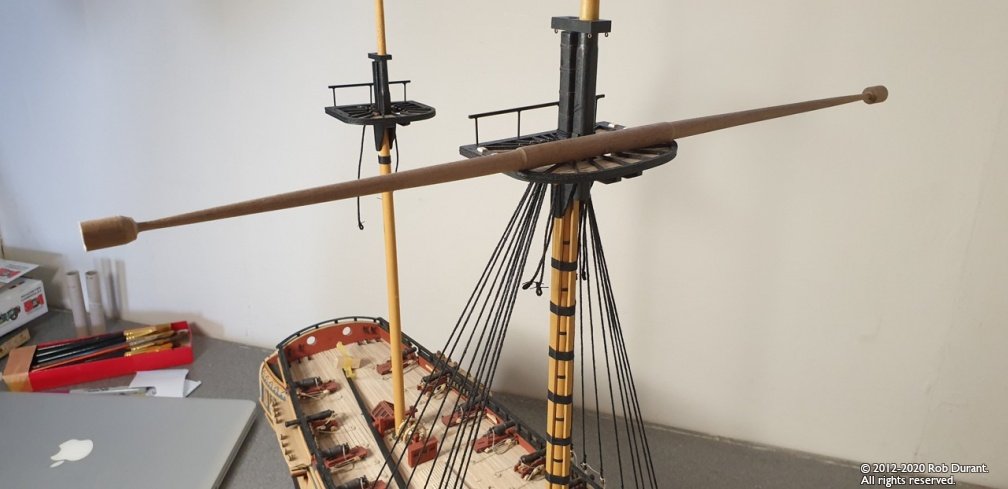
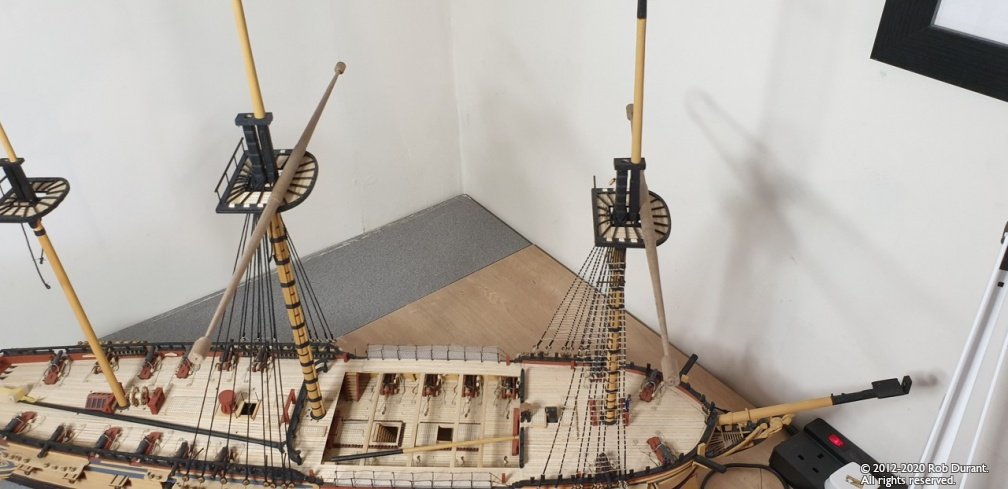
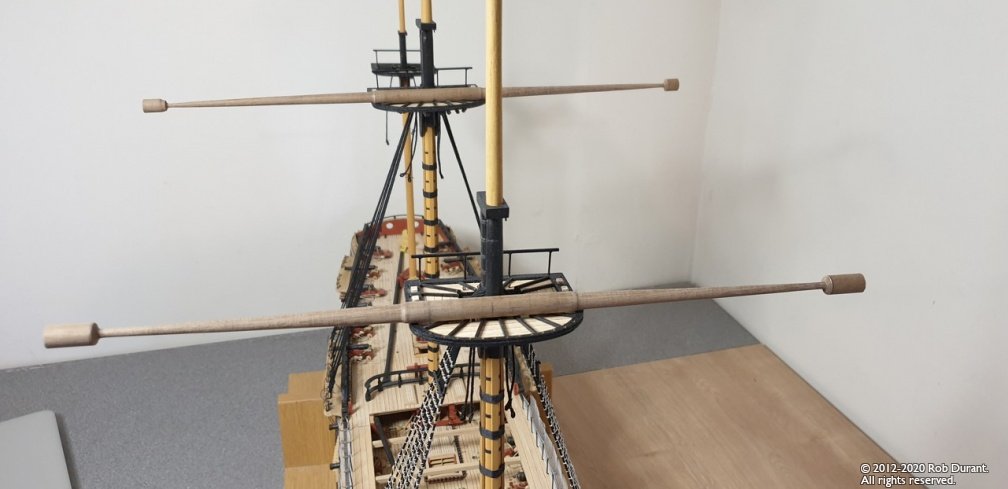
- egkb, JpR62, mort stoll and 3 others
-
 6
6
-
I think this may be the first build log I've seen of Danmark - I remember years ago thinking that it would be rather wonderful to make this kit, but I never have... She's going to look even more splendid when done!
Kits certainly have come on a lot since these were made. I made a Billings Blue Star 25 years ago or so (ABS hull), and the parts for the superstructure were all cut out by hand for that too - at least the lines seemed to be in the right place which was more than I could say for the next kit I built back then. Tedious, but perhaps that brings a greater sense of satisfaction when you get to the other end.Thanks for sharing your progress with us all.
-
Hi all,
It's a few weeks since I last posted, and lots has happened in the shipyard.
Fighting tops
I wanted to finish off the fighting tops, so I could get shrouds in place, and start the (significant) job of the ratlines. That meant constructing the barrier at the back of the fighting tops. I was concerned that wood would be a little vulnerable in that position as I rigged the ship. Also, I suspected that the ship itself had metal posts, and not wooden uprights, so I ordered the smallest square brass cross-section I could fine, and set about soldering them with a little jig made using balsa and pins.
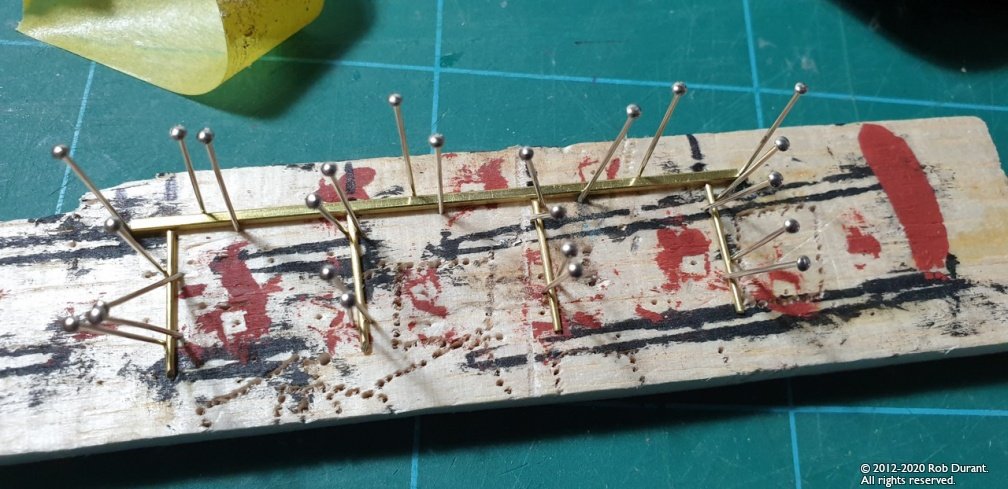
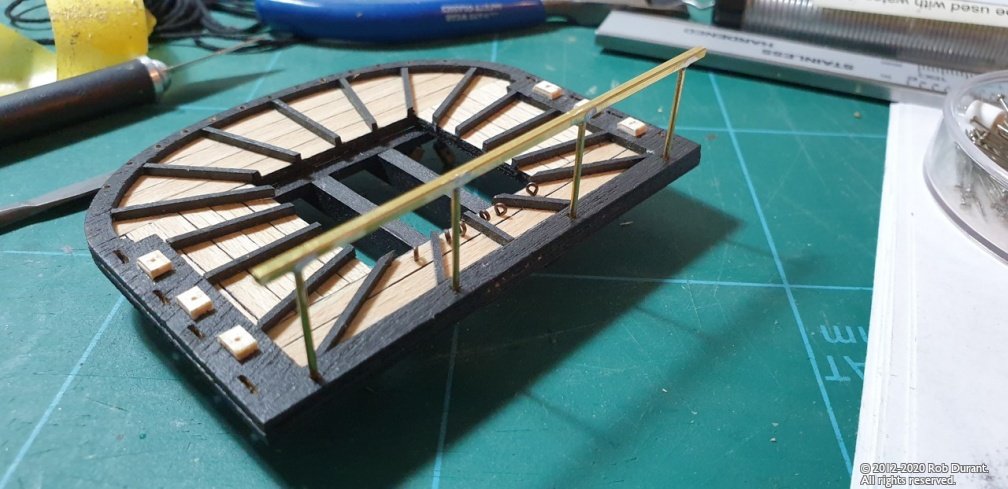
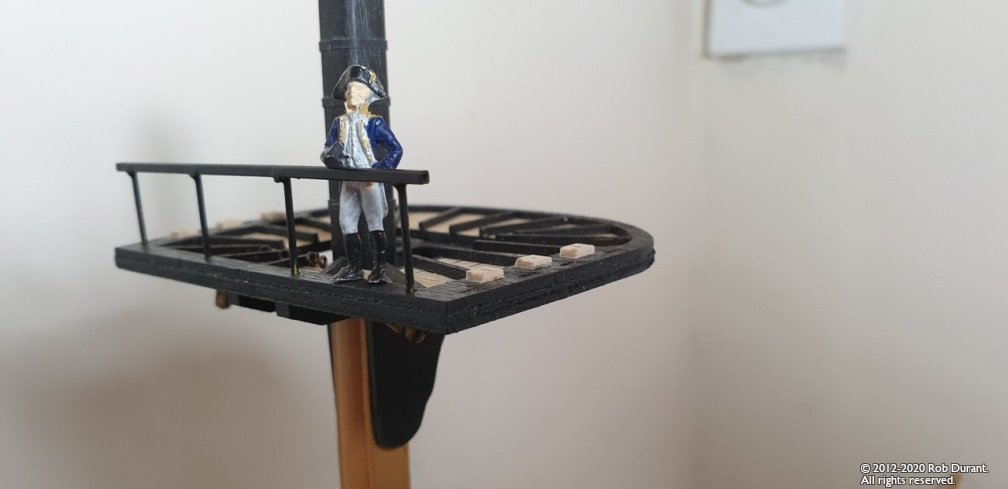
Burton pendants
These are added to the mast before the shrouds - made of 1.25mm thread, tied with .25mm thread and secured with watered down Aliphatic glue (carpenters PVA). My understanding is that they're attachments to which temporary rigging can be fixed when necessary.
Starboard first, Larboard second for the main and fore, one hanging down on either side on the mizzen mast. That was achieved by unravelling the rope in the centre by twisting it - passing it round the mast, and then letting it spring back.
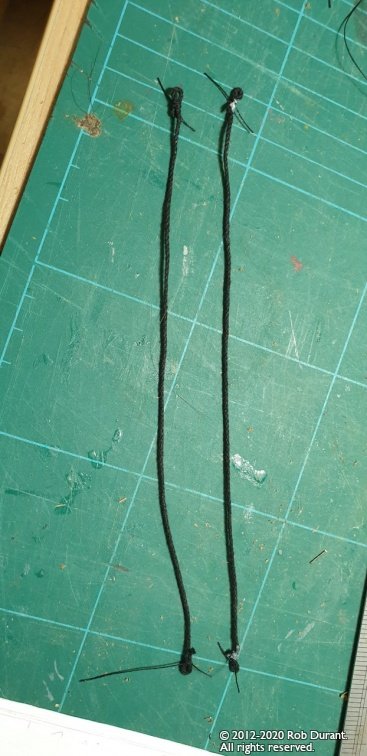
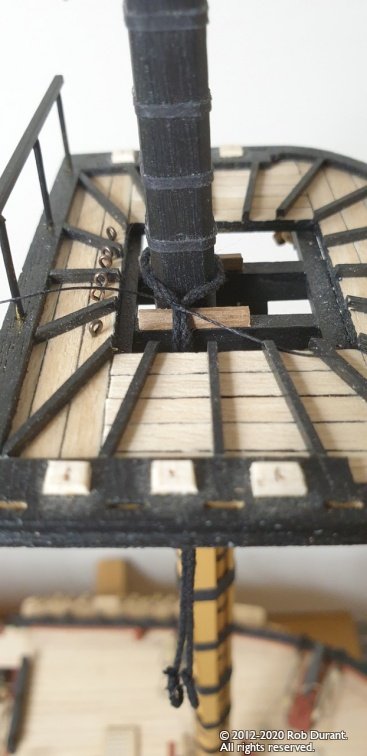
Shrouds
Again, a starboard pair, then a larboard pair - starting at the front and working back. I used 1.25mm black rope for these. (The recommended 1mm looked a bit weedy to me!)
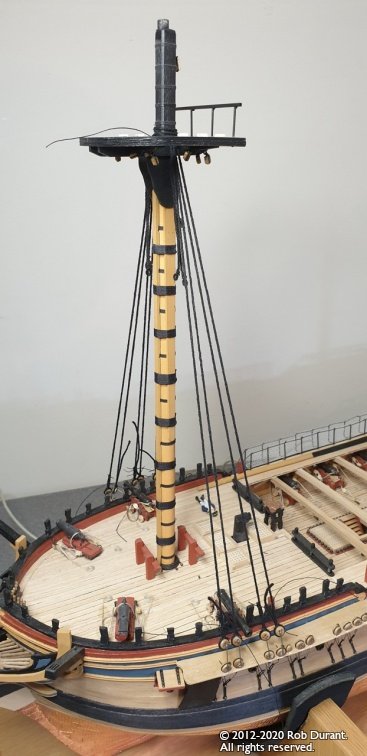
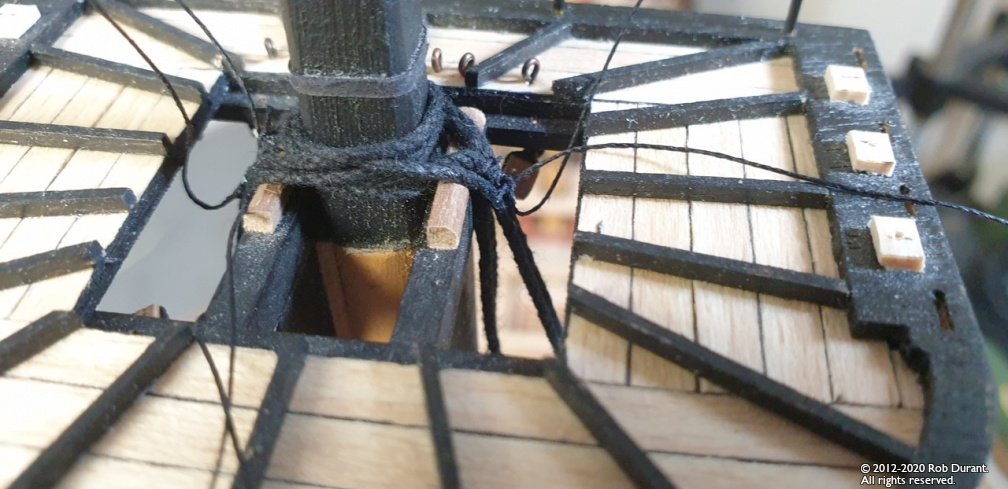
It's worth noting at this point that if the shrouds don't sit on top of each other, but sit side by side (i.e. the higher loops are bigger and sit down around the lower) - you may run out of space between main and top masts, and it will force the base of the topmast forward, thereby stopping the two from being parallel. Thankfully, when I checked this hadn't proven an issue, but it almost caught me out, so hopefully others will avoid the dilemma.
Bent steel wire was used for spacers on the deadeyes whilst rigging the shrouds... I found the recommended brass wire both too large in diameter for the deadeyes, and suspected the wire I had might be too soft.
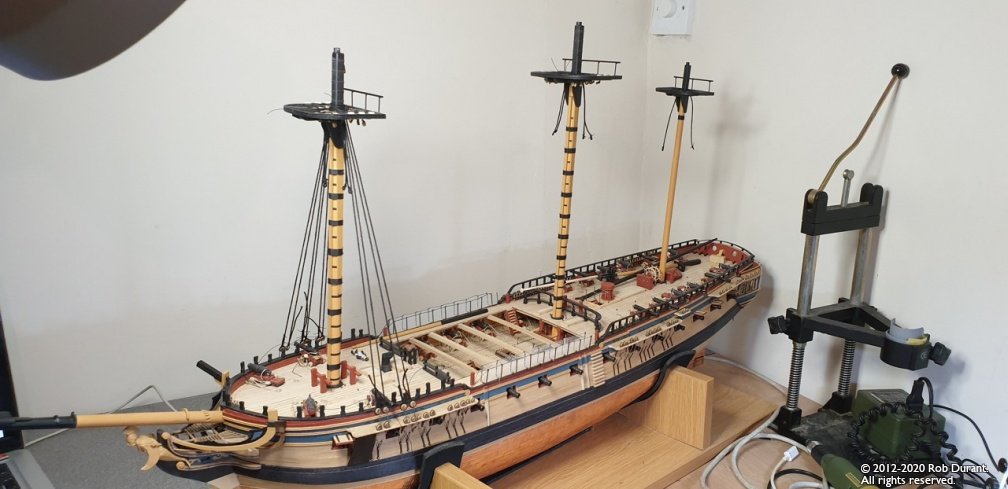
As you can see below, I rigged the lanyards on one side of each shroud pair first, before I secured the other end of the shroud so that I could be confident of the length. As it was, I think I still left the shrouds a little loose, but I didn't want to pull the chainwale off the side of the hull causing all sorts of inglorious muttering and holding of head in hands.
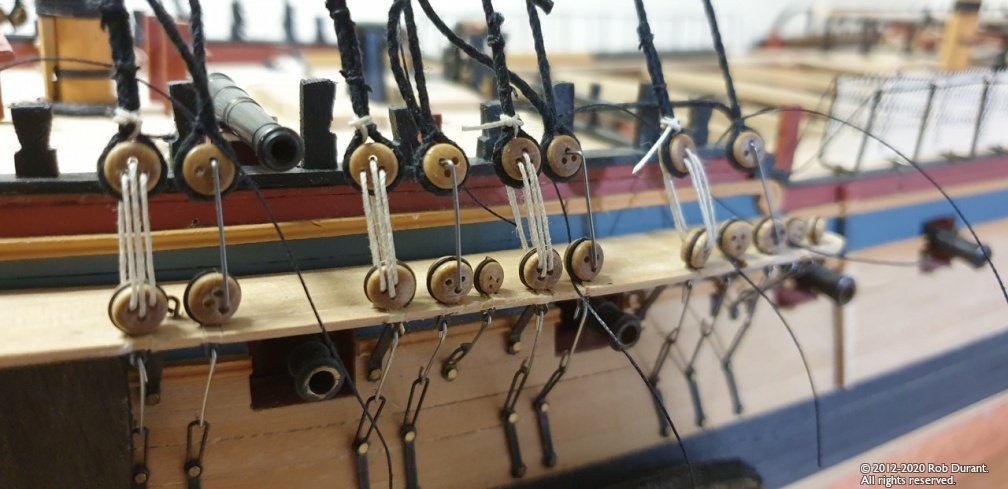
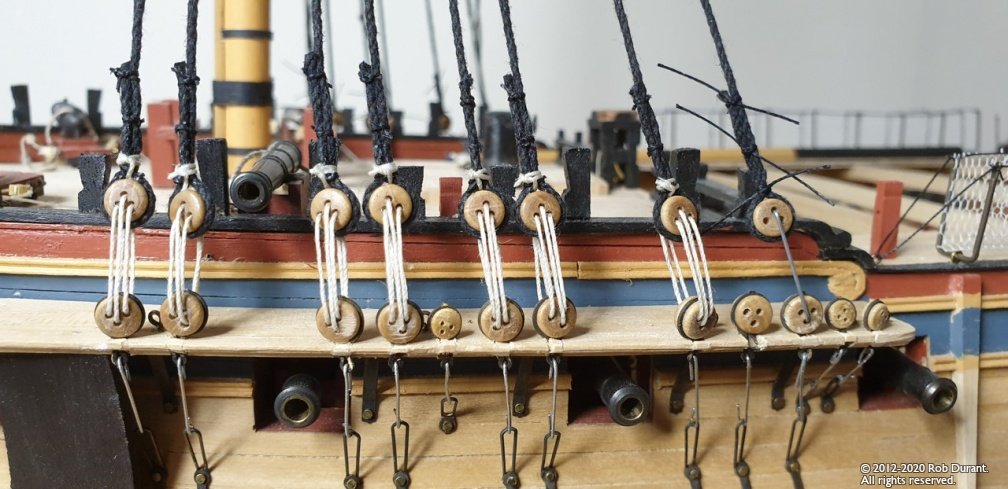
As running rigging, the lanyards were 0.5mm light rope, and I'm quite pleased with the contrast...
Rattling down the ratlines
I wanted to learn serving, and rope-making, but those are going to have to wait for the next model

DISCLAIMER: Now comes the controversial bit. Bear with me here. I've used both light and dark rope in the past for ratlines. I like the light. It's a personal choice. I know it's showy. And this is a showy frigate... just look at the paintwork - the captain would rightly have been proud of this crack frigate... so I've gone with untarred manila! I know it's probably not the right colour, but hey... it's my model
 And I really like the effect it made on my Pickle schooner... Sherborne and Royal Yacht Caroline both look great with black ratlines, but I also found the 0.1mm thread much easier to get neat scale tidy ratlines with... So. That's the decision. I'm 1200 knots in, so the decision is well and truly made... and I'm not about to go anywhere near this model with india ink (as the instructions suggest) - I'm simply not brave / foolish enough to attempt it over neat maple decks.
And I really like the effect it made on my Pickle schooner... Sherborne and Royal Yacht Caroline both look great with black ratlines, but I also found the 0.1mm thread much easier to get neat scale tidy ratlines with... So. That's the decision. I'm 1200 knots in, so the decision is well and truly made... and I'm not about to go anywhere near this model with india ink (as the instructions suggest) - I'm simply not brave / foolish enough to attempt it over neat maple decks.
With that said, I printed off a bunch of CAD sheets with lines 5.8mm apart, and used these as the guides. Here are the pictures of progress so far.
It always takes me a bit of head-scratching to remind myself what a clove hitch looks like... (at least the way I do them - am I wrong again?)
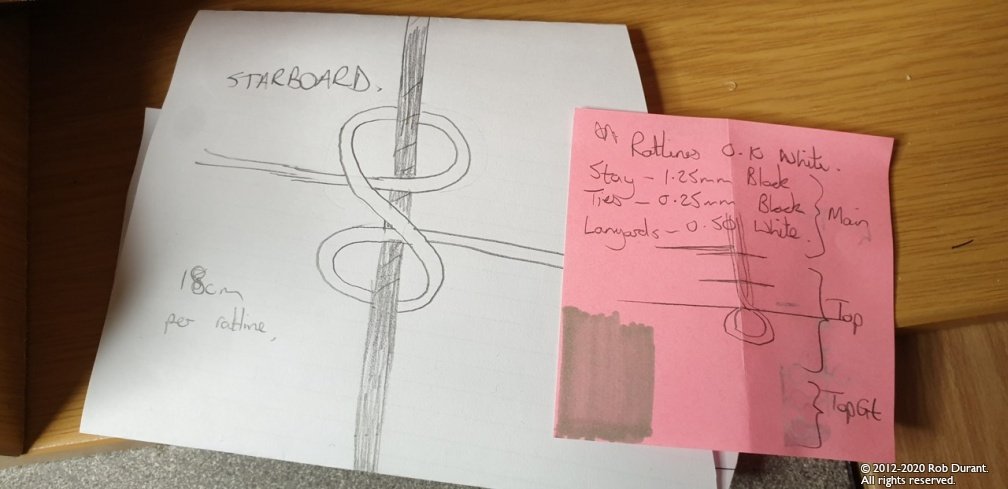
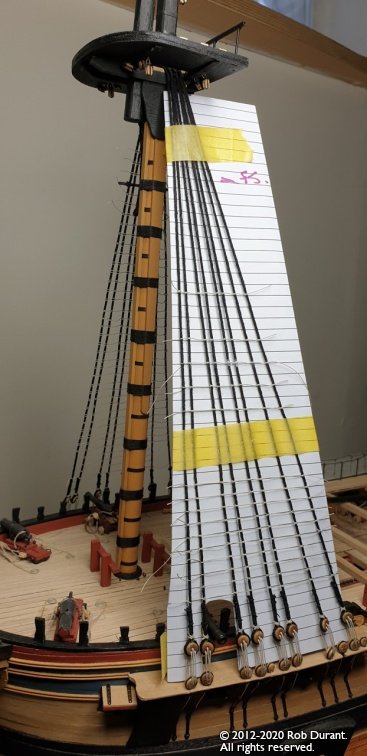
And an inspection of the work so far... I find by applying watered down PVA to each row as I finish it, the whole thing stiffens up quite well, and as I go it gets quicker... This way I can pull out the tension as it shrinks, too and avoid the whole thing bowing in and becoming curved along its length. (to some extent at least...)
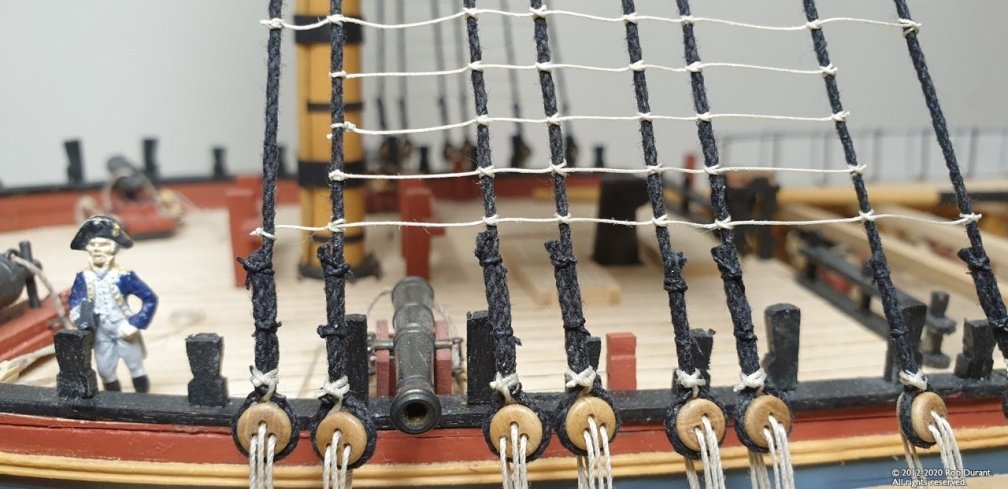
- granta, GrandpaPhil, JpR62 and 8 others
-
 11
11
-
Not sure if it's helpful, (and apologies if this is over-technical - I've tried to keep it simple) but speaking as an internet programmer, it might help to understand a few of the nuts and bolts?
JPEG images (the ".jpg" format we tend to use) are saved by most cameras (and phones) with data embedded in the file called EXIF data... it contains all the information like the camera model, the image size, the colour profile of the photo, and also it CAN contain information on whether the image is rotated... it's a quick and easy way for the phone or camera to say - I've stored this landscape, but actually the camera was vertical, so it's 90 degrees to that... without having to actually move the pixels round (a much more intensive task for a computer)
1. Depending on what you use to view the file, that exif data may or may not be respected... It usually will be on your home computer using the picture viewer... It may not be by your web browser... and the results will vary between windows / mac and different browsers... it isn't that the website server is getting things wrong - it's just how it looks on your computer.
2. When you modify the image - e.g. resize / re-save - depending on which application you use to do that (i.e. iPhone gallery / Windows Photo / Photoshop etc... / online resizer ) that EXIF data may or may not be included. Clearly if it is not included, then when that image is displayed the computer / phone displaying it has no way of knowing that originally it was intended to be rotated...
Basically - if you want it to show the right way round, then don't trust EXIF - you need to force the computer / phone to actually rotate the image data (perhaps using GIMP/ Photoshop or equivalent), not just put a note in the EXIF data. That's the only 100% fool proof method. With that said, I've just updated the script I use to resize my photos to include the EXIF data when it resizes them (it wasn't before) and now the portrait images taken on my phone (which are stored landscape with 90 degree EXIF rotation) show up correctly.
Anyway - hopefully that gives some insight into the complexities of simply getting an image the right way round on a webpage.
And finally - thank you to all you wonderful people who do such a great job of maintaining this forum! You make a complex task look very simple, and I'm sure that takes a lot of behind the scenes effort. Much appreciated.
Rob
-
One question - are each of the planking strakes straight, or did you curve them to fit the hull? It sounds from your description like you made them straight, then used plenty of pva to make them pliable enough to side-bend when fitted?
-
Wow - that's how my first attempt was going to turn out in my head, and mine ended up in the scrap heap... Beautiful work Jason. You have every reason to be pleased. Having just attempted to build this mini-kit, I have some idea of quite how fiddly it is.
-
On 6/8/2020 at 11:45 PM, egkb said:
Hi Rob .. Yup that's gonna be some difference .. Oh and Ethalion in the other photo looks a treat !
Cheers
Eamonn
Hi Eamonn
Thank you for your kind words. There's something very pleasing about working out the lines for yourself - and on the scale of a ship's boat, it's manageable - I'm in awe of those who try to draft entire ships themselves. That's another level!
On 6/14/2020 at 2:23 PM, Beef Wellington said:Hi Rob, I'm always amazed at your very thoughtful and methodical approaches to things using the CAD drawings, I really want to learn that. Your cutter framing is looking fantastic. You'll have a
really solid foundation there, and the photos always seem to belay the small scale of these things, feel like all fingers and thumbs. All the best!
Thanks Jason
It's going to be immensely over-engineered, but that's the joy of this hobby... I can choose to spend more time than is rational, simply because I want to

I hadn't quite appreciated how small it was on the screen, but when I printed it out and began to cut it out, the challenge became apparent pretty quickly! Thankfully the parts are quick to shape because they're so small. Any mistakes, and one can simply make the part again.
I taught myself 2D CAD using QCAD Pro, because I got frustrated with trying to get other applications such as Word to print things out at the right scale, and it's proved useful time and again as I've worked through this build.
Rob
-
Time for another update, although progress has been limited.
I've done a little to the pinnace, drafting, cutting out and making a build board for the skeleton of the boat. I'm hoping to make the keel a snug fit but not glue it, and then once the hull's planked, I shall try and lift keel and shell off the former... then I can add scale frames, and details. That's the plan. Time will tell whether it works. I'm beginning to realise that I wrongly assumed that thin planks would make planking the boat easier - in fact, if anything slightly thicker stock may be easier, as it is more forgiving to be sanded down to achieve a neat shape... I'm interested by Jason (Beef Wellington)'s suggestion he may use card to create a clinker effect... the thought had crossed my mind (having done a little work on a Shipyard Models HMS Mercury)... perhaps natural wood on the inside, and card on the outside? We'll see. Some of these photos have the caldercraft supplied frame alongside to show the difference.
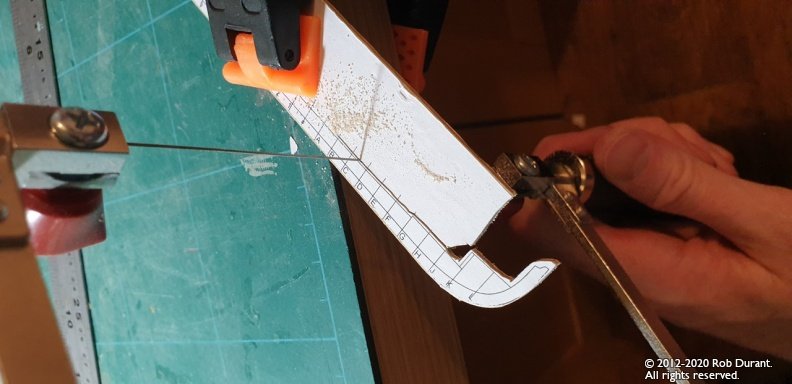
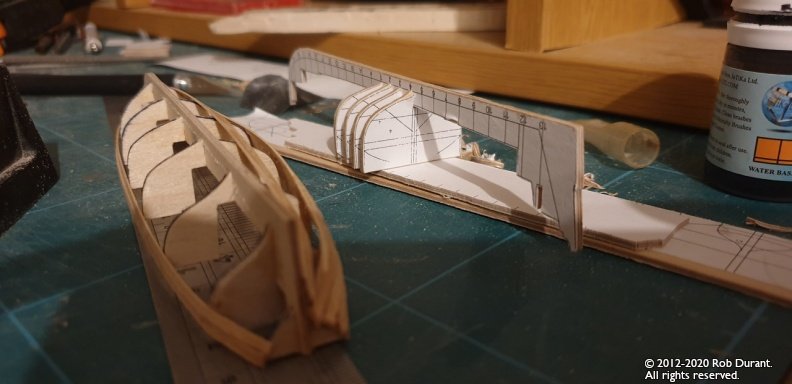
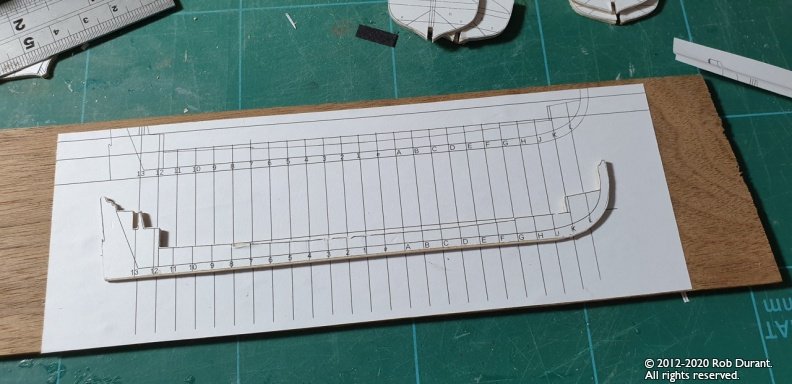
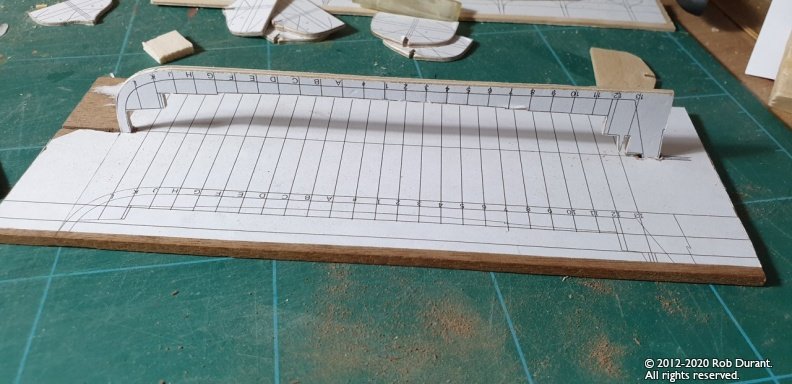
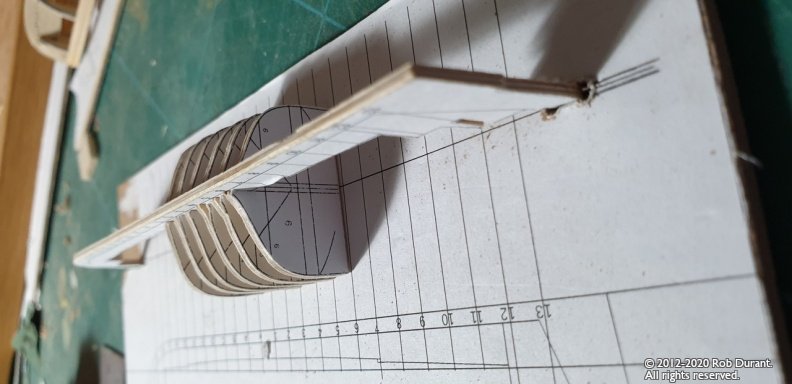
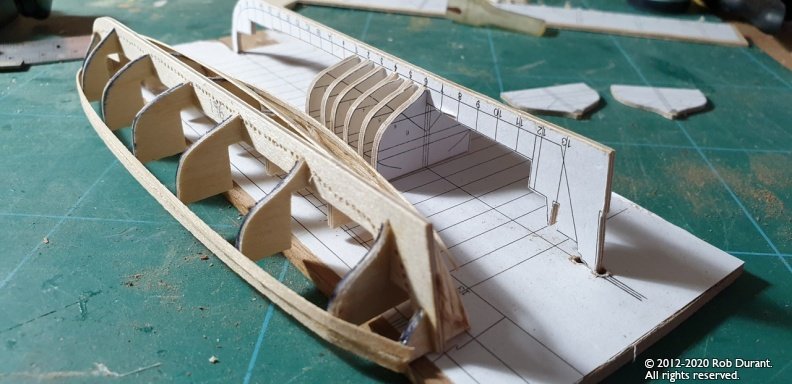
In addition, I've finally finished the cross trees for the top mast / topgallant mast junction. These were small and fiddly, and the wood wasn't the best, but I'm pleased enough with the outcome. This photo is of the smallest - the mizzen cross tree - note the lack of holes on the foremost cross member. I'm using the topgallant mast as a spacer to make sure the mast fits once it's all glued. These are now painted, and the ship has reached her full height. (All dry-fitted - hence the slightly odd angles - until the rigging is well under way - indeed, much of this will remain dry-fitted once complete, as the rigging holds it all nicely in place.
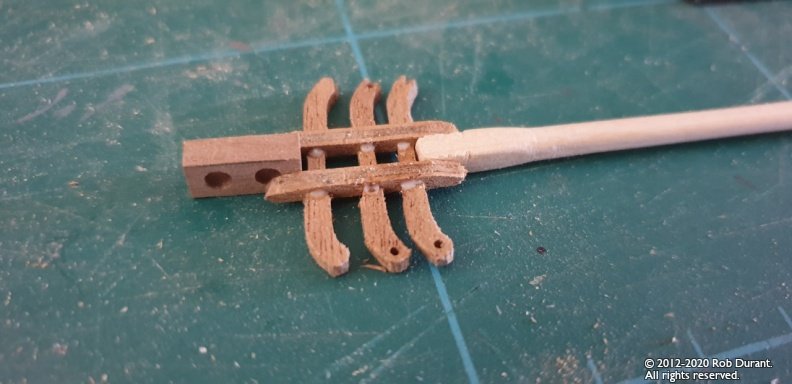
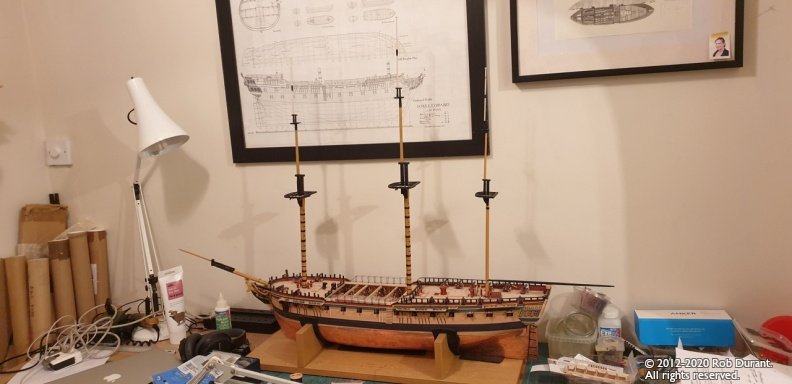
-
How interesting. Thank you. Yes it would be fascinating to understand the journey from one usage to the other.
-
-
Thanks Jason
I've been pondering the ship's boats... (My backup plan is to buy the caldercraft resin boats - which are okay, but a bit pointy at the bow, and I'd rather conquer the challenge myself) The kit bulkheads have caused me no end of trouble so far. I couldn't get the curves at either bow or stern, and if I wanted to make the center removable I couldn't get the planks to stay together. It's weird, because I managed the ship's boat on Royal Yacht Caroline - for some reason this is just fighting harder.
Anyway - I decided to go back to basics. I had a look on the RMG website for 32 foot pinnaces and found a design from Portsmouth from a few years before Ethalion was launched. J0859, here: https://prints.rmg.co.uk/products/32-ft-pinnace-j0859?_pos=18&_sid=f62fc5df9&_ss=r
And I've been creating my own framework to build the boat on... As below:

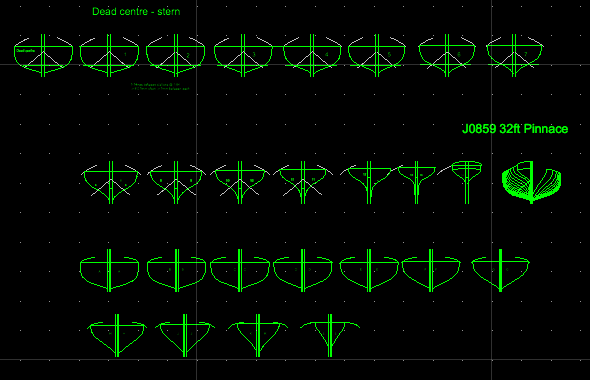
It's a work in progress, but the resulting frame should be much much better for laying those really thin veneers onto, and getting a good curve. So far I've only cut out a few of the bulkheads to test out my theory. The design is printed onto A4 paper, glued (with Pritt-Stick / UHU-stick) onto 1.5mm ply, and then cut out with a piercing saw and finetuned to the line with sand paper and files. It's time-consuming, but quite rewarding really. As you can see, I haven't cut the centre slots yet... they weren't on the design when I did these ones. They are now. I'll add them manually for these bulkheads.
As you can also see, the bulkheads all stretch up to a universal line, so that they can be mounted upside down on a board, as I believe Harold Hahn did for his models.
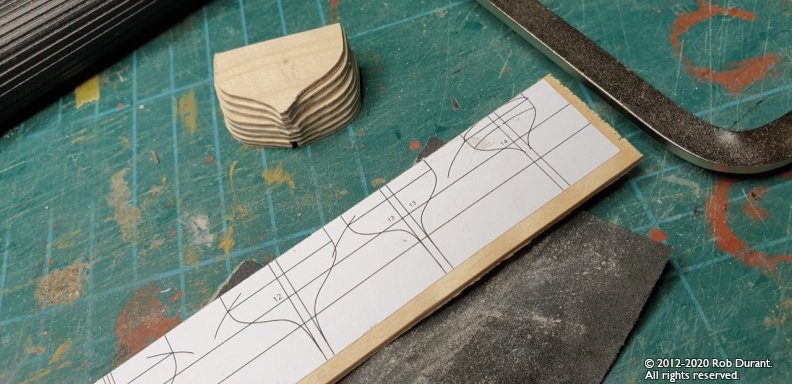
As I say the designs are very much in progress, but here are the frames as an A4 PDF if you want to take a look.
wip_32ftpinnace_bulkheads.20200517.pdf
I expect to build the frame over the bulkheads and then remove the majority of the bulkheads - but time will tell how that really works out.
Anyway - that's my thinking so far.
Rob
- Siegfried, Barbossa, chris watton and 4 others
-
 7
7
-
The BInnacle (courtesy of Vanguard Model's excellent mini-kit!)
Here's the space it's going into...
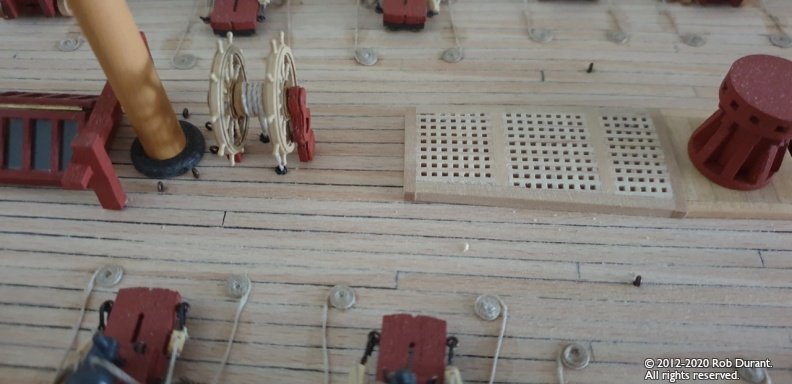
The kit is a single sheet of laser cut pear, well packed in solid mdf.

There are no instructions,but it's a pretty simple shape with plenty of support, so it isn't too fiddly.
(13th August 2020: UPDATE - My apologies to Chris. There are instructions, but they're on the website on the page where you can buy these binnacle kits... just click on the image thumbnail, and you'll see very clear instructions on how to assemble this brilliant mini-kit)
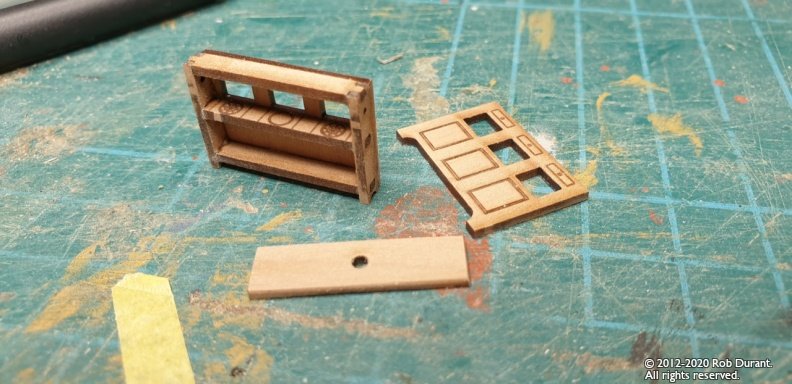
I decided against putting the compass and lantern inside as it's virtaully impossible to see, but I'm sure others will choose to

The next step was to put on a chimney, as per the Victory binnacle below (my photo):
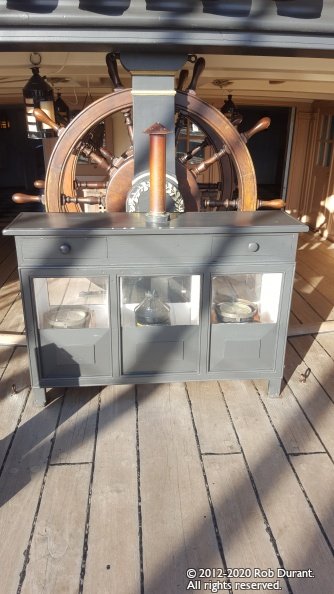
The first attempt was with a paper cone at the top...
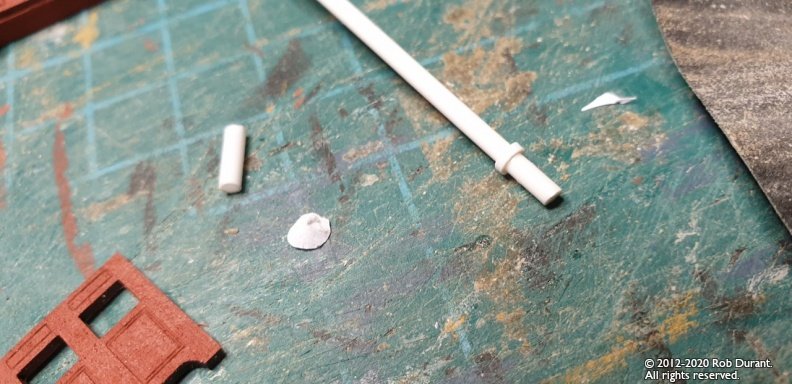
The paper cone was far too fragile, and (for me at least) was just a mess.
The second attempt was with plasticard mounted in my mini drill and files...
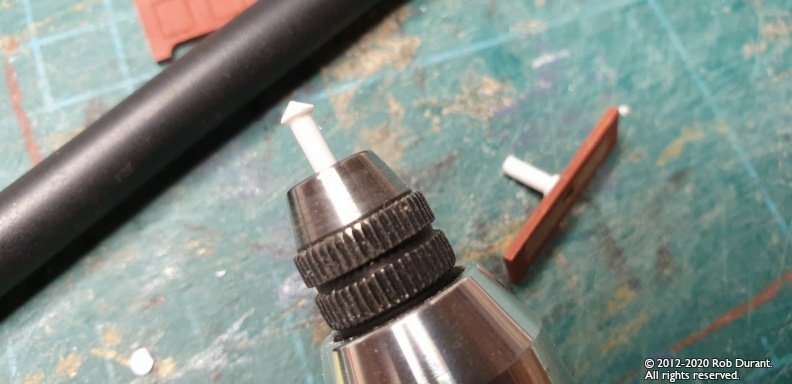
A little ring of styrene tube was added at the bottom.
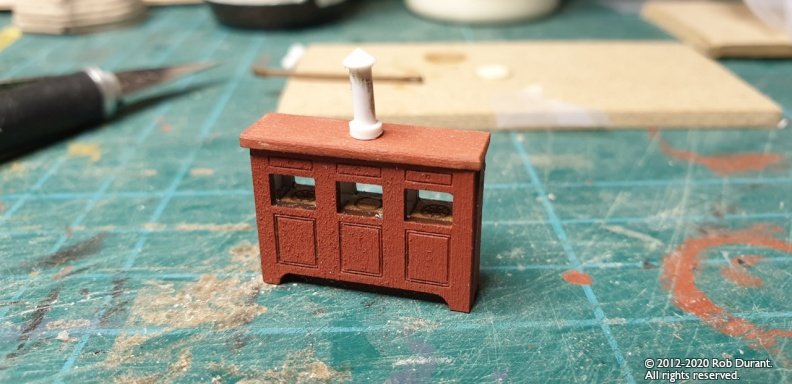
I left off the back side so I could glaze the windows (having painted as much as possible - inside, white, outside, red).
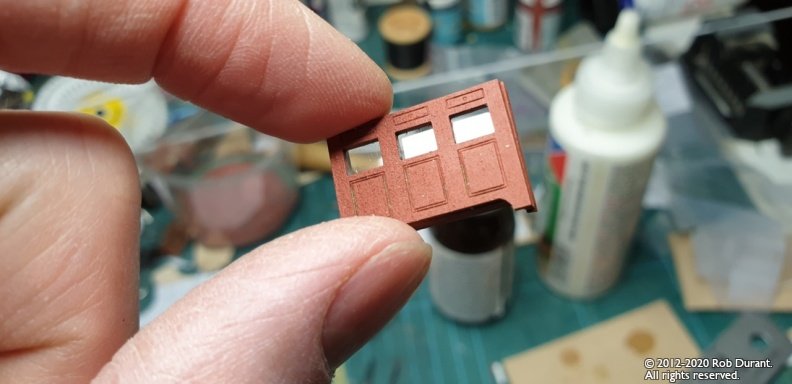
And then it was time for final assembly, some light sanding, a final coat of paint and fitting to the model so that the guys at the wheel can steer true!
The chimney was painted with black then copper to give the copper a darker toned down sheen.
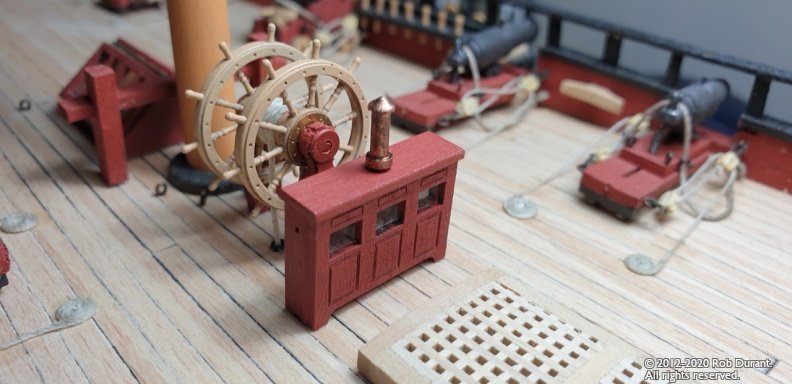
Thanks Chris for an excellent addition - I've been surprised by how much it adds to the quarterdeck when put alongside the upgraded ship's wheel. It really looks the part.
Happy building
Rob
- JpR62, chris watton, BenD and 6 others
-
 9
9
-
Wow - I ordered from you on Tuesday, and lo and behold, the binnacle's here already. I look forward to assembling it forthwith. It's the first sight I've had of the work you're now doing with your laser cutter, and it looks exceptional!
Thank you Chris.
- BobG, chris watton, mtaylor and 1 other
-
 4
4

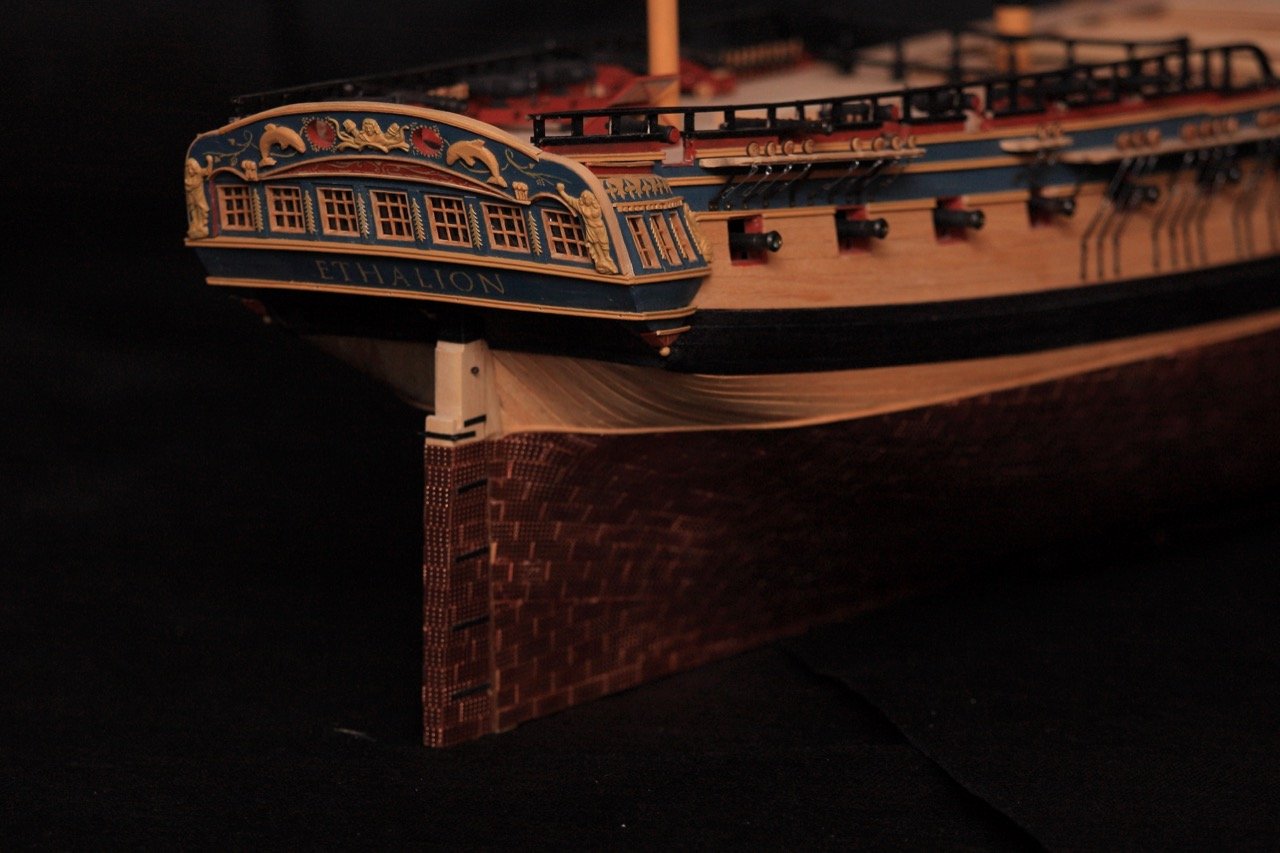


Question regarding applying CA glue to plastic models
in Painting, finishing and weathering products and techniques
Posted · Edited by robdurant
Clarifying
I tend to put a little on a scrap of card and use a cocktail stick to pick up a little and move it to the joint. If it's thin ca glue, capillary action will draw the glue in between parts. The angle of the cocktail stick can change the size of the drop of glue on the end... then it's just experience and getting a feel for it.
There are plenty on this forum who are far better at this than me though so there may be better advice forthcoming